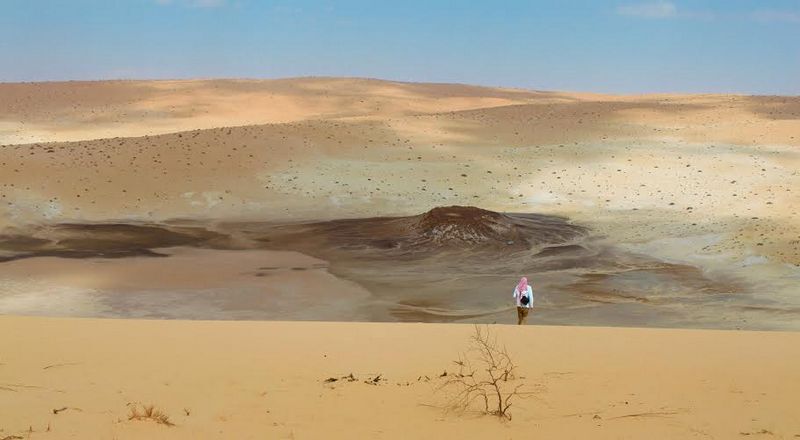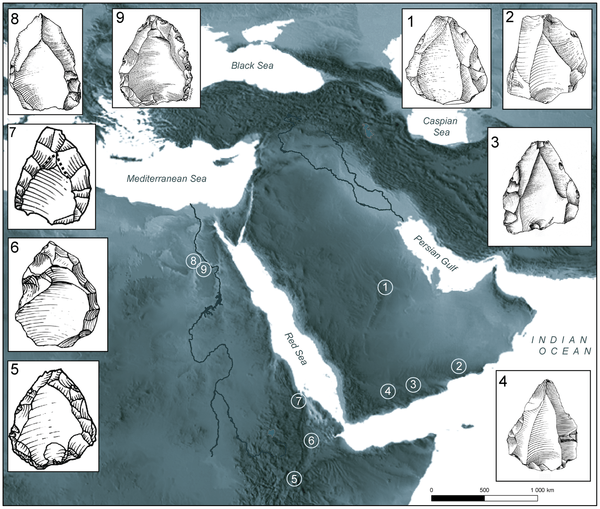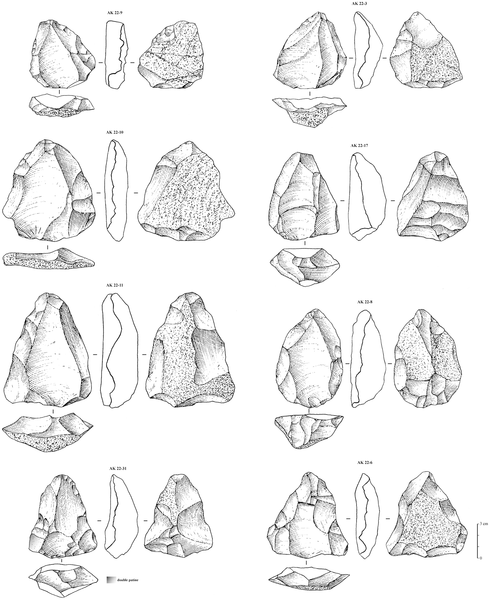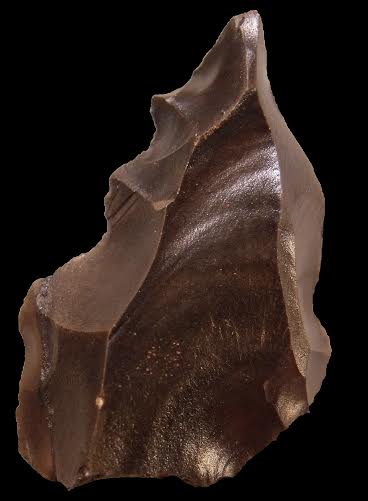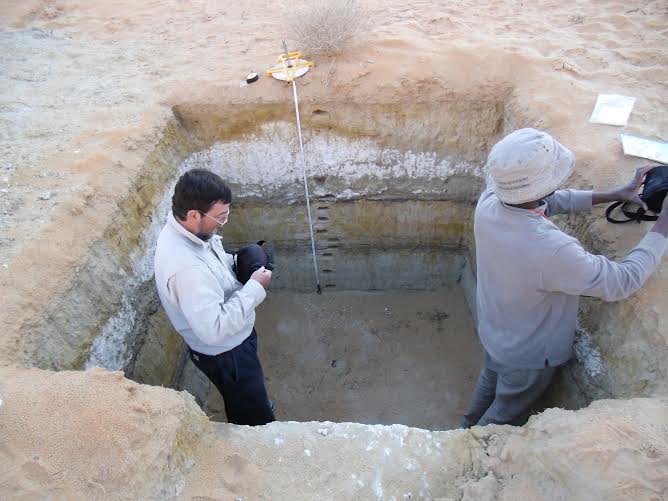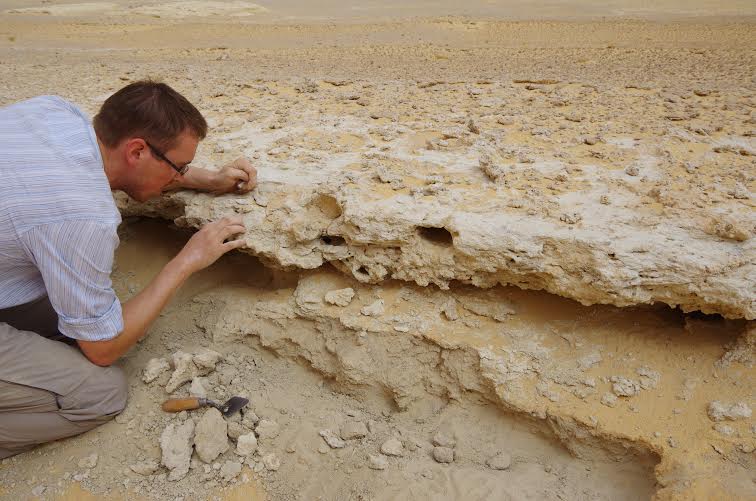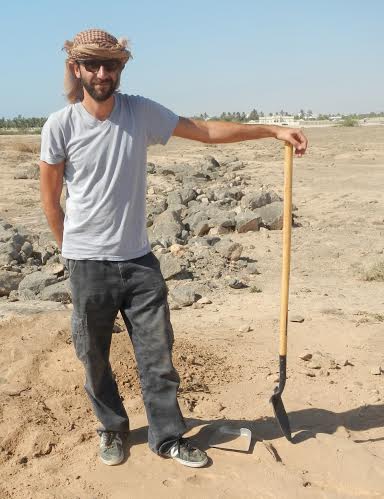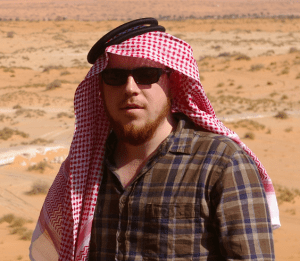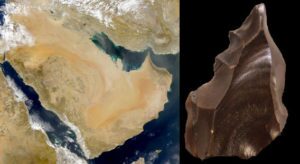
Winter in Saudi Arabia is nearly perfect for archaeological fieldwork—it is neither too hot nor too cold, and it is most always sunny, says Dr. Huw Groucutt, an archaeologist with the University of Oxford. Groucutt has been conducting archaeological research on the Arabian Peninsula for years, along with other senior colleagues such as Prof. Michael Petraglia, also of Oxford University, and Dr. Rémy Crassard, of the Centre National de la Recherche Scientifique (CNRS). They are prominent pioneers in the ongoing research of human prehistory in this region of the world, especially related to Paleolithic times.
It has been something of an archaeological flurry. In recent years, Groucutt and his colleagues have been discovering sites across the Arabian Peninsula that bear on the entire time spectrum of human prehistory, beginning with the Lower Paleolithic (probably dating to more than one million years ago in some cases). No longer regarded as a cul-de-sac for studies on human evolution and dispersals, the area has quickly emerged as a major theater for exploration and scholarship in the evolving story of early humans and their dispersal across the globe.
Early on, while doing his PhD work, Groucutt began working with Petraglia to research the Arabian Middle Paleolithic in Saudi Arabia. Petraglia had already spent 10 years doing research in the country, and “things were ready for a big expansion in research,” according to Groucutt.
And expand it did.
“Over the last two years we have done two months of fieldwork a year, and the discoveries have been flowing in thick and fast,” he says.
Now with his Ph.D, Groucutt is referring here to the work that is being done in connection with the Palaeodeserts Project. Headed by Petraglia, it organizes the efforts of a multidisciplinary team of researchers to find answers to questions related to the effect environmental change has had on early humans and animals that have passed through and settled this desert subcontinent over the past 1+ million years. Along the way, they have uncovered a profusion of lithic (stone tool) assemblages left by humans at locations in Saudi Arabia. The finds testify to a human presence that dates back hundreds of thousands of years, researchers suggest, marking the trail and habitation zones of humans that followed and exploited green zones created by climatic humid or “wet periods” in an otherwise harsh, arid Arabian palaeoenvironmental history. Focusing for the purposes of this article on the mid-to-late Paleolithic period, the research could have profound implications in the debate on early human dispersal theories out of Africa, particularly those related to anatomically modern humans (AMH), and it is already making its mark in the scholarly world of human prehistory studies.
The recent study reports on the topic have been pored over by scientists and academes alike. But they contain terms, concepts, and process descriptions that are familiar only to them. To elucidate the picture for a general readership in detail, Popular Archaeology interviewed Groucutt and Crassard, with additional input from Dr. Ash Parton, specialist on palaeoenvironmental change for the Palaeodeserts project. What follows is what they had to say:
___________________________________
Q: What have been the most significant Middle Paleolithic finds on the Arabian Peninsula that bear on the presence of anatomically modern human hunter-gatherers there?
Crassard:
To date, there has been no trace of fossilized hominin prior to the Holocene on the Arabian Peninsula. It is thus difficult to affirm with no doubt that AMHs (Anatomically Modern Humans) were present in Arabia during the Middle Paleolithic. This means that Neanderthals could have been there as well, as suggested in a paper we did on a site excavated in Yemen (Delagnes et al. JHE 2012: “Whether or not the Middle Paleolithic occupation of Wadi Surdud can be attributed to modern humans or to a human group related to the Neanderthals remains a totally open question. As no sound technological markers exist for distinguishing Neanderthals from early modern humans, neither of these alternatives can be ruled out”).
The stratified and thus dated sites are still very rare in the whole Peninsula for the Paleolithic period (most identified sites are surface scatters), and the only available data consists of stone tools. There is no evidence of symbolic activity, nor a robust faunal record, so the subsistence strategies are also unknown. One possibility for testing hypotheses relating to identifying the kinds of human species in Arabia during the Middle Paleolithic is to compare stone tools. Among several types of stone tools, bifacial tools, or hand axes, have been found at Jebel Faya in the United Arab Emirates, and they have been considered as a AMH production, dated to about 125,000 years. This interpretation is not always accepted by the scientific community, as they could have been produced by other human antecessors.
Another type of stone technology is interesting for tracing the demographic expansion of Homo sapiens. This is the Nubian technology. This kind of predetermined flake production on stone (chert, flint, quartzite…) was previously known only in northeastern Africa, until it was found in south Arabia (especially in the region of Dhofar (see Rose et al. Plos One 2011), in Oman, but also in Hadramawt in Yemen), and more recently in central Saudi Arabia, close to the modern city of Al-Kharj (Crassard & Hilbert, Plos One 2013). This technology is dated to more than 100,000 years in Arabia, a technology that seems to have only otherwise been produced by AMHs in Africa. Further research is needed, including new dates and stratified sites, to confirm these interpretations.
Groucutt:
Firstly, we must emphasize that interpretive caution is needed as no hominin fossils are known from before the Holocene (i.e. the last 12,000 years) in Arabia. So we are talking exclusively about lithic (‘stone tool’) technologies. Variation in lithic technologies reflects many factors, such as the influences of different types of raw materials (chert, quartzite, quartz, volcanic raw materials, etc.) used and other such ‘pragmatic’ factors, as well as the role ‘cultural’ variation may have played. Variants of Middle Palaeolithic technology are complicated and sophisticated, showing patterning in space and time. Such factors are important indications that we are dealing with learned (i.e. cultural) behaviors. As a result we should be able to look at how lithic technology varies in space and time and understand how populations moved through the landscape (i.e. dispersals) and how they responded to changes in their environment.
With that background, three major finds/groups of finds in Arabia have been argued to relate to the dispersal of anatomically modern humans (AMH). The first, published by Professor Simon Armitage, et al. (2011), in the journal Science, relates to the Jebel Faya rockshelter in the United Arab Emirates. This was the first site in Arabia for which absolute age estimates were published (using a technique called Optically Stimulated Luminescence or OSL dating, which allows us to date sites which are beyond the limits of radiocarbon dating). The excavators at Jebel Faya recovered several buried assemblages of lithics. They argue that the younger ones are unique and so represent a local population, perhaps isolated in this region. Attention has focused on the deeper (older) assemblage (‘Assemblage C’) which appears to have been been buried ~125 thousand years ago (the ‘Last Interglacial’). The discoverers argue that features of this assemblage demonstrate similarities to African ‘Middle Stone Age’ sites associated with early AMH. This is based on the combination of tool types found at the site – Levallois cores and flakes (flakes struck from specially prepared nodules of rock (cores) which result in flakes of a particular, predetermined shape), blades (long, thin flakes) and bifacial tools. Not much information has been published on the lithics yet, so it is difficult for other scholars to critically examine these claims. But arguably caution is needed and the position of Jebel Faya is still very much open to debate. For example, the discoverers reject connections with areas of the Levant as these are suggested to lack the tool types found at Jebel Faya. Yet sites such as Skhul in modern day Israel have bifaces, Levallois technology and blades.
The second major claim from Arabia comes from the discovery of a large number of archaeological sites which the discoverers describe as belonging to the ‘Nubian Complex’. Most of the sites in Arabia, published by Dr Jeff Rose and his colleagues, are in the Dhofar region of Oman, but before that similar technology had been found at lower frequencies in Yemen by Dr Rémy Crassard and others. More recently Dr Crassard and others have also found Nubian technology at Al Kharj in central Saudi Arabia. Nubian Levallois technology is a particular form of Levallois technology, where nodules of rock (‘cores’) are specially shaped. In this variant they are shaped in a way which produces pointed flakes (‘Levallois points’). Nubian technology was previously best known from northeast Africa (‘Nubia’), so a lot of people are very excited about its discovery in Arabia, seeing it as strong evidence that populations of AMH dispersed into Arabia more than 100 thousand years ago. This is again possible, but there have not yet been many detailed comparative studies. And with different types of Levallois technology we must always be wary of technologies being re-invented. Nubian or analogous technology is in fact known from Mauritania to India, and from central Saudi Arabia to Kenya. The presence of Nubian Levallois technology in Arabia is important, but it is not necessarily a smoking gun for dispersal out of Africa.
Finally, we on the Palaeodeserts Project (based at the University of Oxford but with collaborators at various international institutions), working in collaboration with the Saudi Commission for Tourism and Antiquities, have made a number of discoveries in Saudi Arabia. A basic point which must be made is that to understand movements out of Africa, we need to look at areas close to Africa. Jebel Faya, for instance, is about 2,000 km from Africa. Palaeodeserts Project fieldwork has identified dozens of new Middle Palaeolithic sites in Arabia, mostly associated with either ancient lakes and rivers, and/or with sources of raw material suitable for making lithics. We have worked in the Nefud desert of northern Arabia, central Arabia and southwestern Saudi Arabia. In these areas we have found Middle Palaeolithic sites of many ages and varieties. We are currently analyzing these discoveries and conducting laboratory assessments of sediments to understand the age of the sites and the nature of the environments, when occupied. What we are finding is that a lot of the sites date to what is called Marine Isotope Stage (MIS) 5, a climatic period which dates from around 130 to 75 thousand years ago. This time saw several periods of much warmer climate, which led to wetter conditions in Arabia. Lots of these MIS 5 sites share similar technology, particularly centripetal Levallois cores, which are flaked in a radial fashion around the edges of the core producing large numbers of flakes of predetermined shape. This is the standard way of producing flakes for much of the African Middle Stone Age, unlike more specific forms such as Nubian Levallois technology. We are also finding some particular tool types such as retouched points. These kinds of toolkits, both in terms of ‘core reduction strategies’ (types of Levallois technology) and of the tools then made are found in Africa for a long period associated with AMH, in the Levant with the earliest known AMH outside Africa (e.g. Skhul, Qafzeh) and at sites in India dating to more than 75 thousand years ago.
So what we really need to understand about the movement of AMH into Arabia is the demonstration of similarities with multiple constellations of technological features, not one feature or one tool type. Conclusions will be much more robust when this is done (we are currently doing this). But history shows that caution is needed. For example, a single site in Saudi Arabia had been suggested to share similarities with the ‘Aterian’ industry of North Africa (again MIS 5, and associated with AMH). A detailed reanalysis of the material by Dr. Eleanor Scerri (currently Université de Bordeaux and University of Oxford) however strongly suggested that the undated Saudi assemblage did not relate to the Aterian at all, but was a more-or-less similar form of technology that had been reinvented there in the last few thousand years. We think such findings are very important when making major claims based only on one aspect of technology. So aside from trying to identify repeated constellations of features it is also critical to have sites which are from secure contexts so that they can be dated. This is what the scientists with Palaeodeserts are doing at several sites in interior Saudi Arabia.
Finally, we must note that other claims for the dispersal of AMH out of Africa, such as the view of Professor Sir Paul Mellars that there was a single dispersal, around 60-50 ka, along the coastline out of Africa and around Arabia apparently associated with small and finely shaped ‘geometric microliths’, is not supported by any evidence in Arabia. Mellars’ model may indeed be true, and he has published his ideas in a number of the leading journals of the world, and he points to a rise in sea levels which would have covered the route taken by the earliest successful (i.e. ancestors of today, not dead-end populations) AMH to leave Africa. This is possible, but in many areas of southern Arabia there is a very steep coastal shelf so changing sea level hasn’t changed that much. Also in some areas tectonic uplift means that we have preserved sections of coastline. Given that extensive surveys have been conducted along the southern Arabian coastline, which have failed to produce any evidence at all for the kind of evidence predicted by Mellars’ model, we think this single dispersal model unlikely for now.
______________________________________
View of area being surveyed for archaeological sites in the western part of the Nefud desert. (credit: Eleanor Scerri/Palaeodeserts Project)
____________________________
Dr Huw Groucutt (University of Oxford) systematically collecting a dense scatter of artifacts on the shore of an ancient lake dating to around 85,000 years ago at Mundafan, southwestern Saudi Arabia. (credit: Richard Jennings/Palaeodeserts Project)
____________________________
Excavation of a Middle Palaeolithic site at Jubbah (credit: Richard Jennings/Palaeodeserts Project)
_______________________________
Q: What possible implications do the finds have within the context of current theories about the dispersal of anatomically modern humans out of Africa?
Crassard:
Arabia is regularly seen as a periphery to Africa. And this is logical, as it is the closest subcontinent to the region of emergence of the first AMHs. But the question of how this dispersal out of Africa was accomplished is really central to current debates. Two main hypotheses are being tested today through a very active (that is recent) research in Arabia: the coastal dispersal and the more inland, perhaps more complex dispersal into and within Arabia.
The international teams working today on these questions are placing a lot of emphasis on the relationship between human groups and climate evolution, as well as topography of the environment in general. Genetics studies are also important in these debates, as molecular geneticists have suggested that human populations have rapidly migrated to the East along the Indian Ocean coasts about 65,000 years ago; but recent discoveries may demonstrate a much earlier dispersal of AMH, or Homo sapiens.
The first results from the Jubbah and Mundafan paleolakes research (international team lead by Michael Petraglia (University of Oxford)) are very promising, as well as the research conducted along the Red Sea coasts by another international project lead by Geoff Bailey (University of York) and Geoffrey King (Institut de Physique du Globe, Paris). The Green Arabia conference, recently held in Oxford and organized by the Palaeodeserts team, featured presentations that very accurately elaborated on the state of the art relating to the actual debates in the region.
As mentioned before, the Nubian technology is an important discovery that needs more dating and more stratified sites; but the comparison with a very peculiar technology that was only known in Africa can really add a lot to this debate. This will be investigated by several teams working in Saudi Arabia (including my work and colleagues) and Oman (including the work of Jeffrey Rose and colleagues).
Groucutt:
As I mentioned, there are several theories about the dispersal of AMH out of Africa, and this in fact is one of the most exciting areas of research in hominin evolutionary studies. The differences between the theories concern a number of factors such as the causes of dispersal, the timing, the routes taken and the number of dispersals.
These different theories for dispersal out of Africa can be divided in many ways. There is a major split between those who think that dispersal at least began during the wetter climatic conditions of MIS 5, when either side of the Red Sea was a broadly similar environment, and those who think that successful dispersals out of Africa only occurred after MIS 5, around 60-50 thousand years ago. Within these different models, many different variants have been published and discussed. Aside from debates about the onset of dispersal, there are debates between those who think there were multiple dispersals out of Africa (a theory that seems likely me to) and those who argue there was only ever a single dispersal (based on some genetics ‘story telling’, discussed more below).
Each of these theories cites combined evidence from several disciplines (e.g. archaeology, the study of human fossils, genetic variability). Outside the small area of the Levant very little is known about archaeology in Asia before about 40 ka, with few well excavated and dated sites. Likewise, outside the Levant there are very few fossils of early modern humans. This may be because they were not there, but perhaps equally as likely it is just about limited research and poor preservation in some areas. As a result of these historical weaknesses in the archaeological and fossil record, patterns of genetic variability have become very important. And it can be argued that many theories really hang on the genetics, backfitting other evidence to this. Traditionally most genetic studies looked at ‘single loci’ such as mitochondrial DNA or the Y chromosome. These give useful information, but only reflect a very small component of our genetic makeup and are prone to over-interpretation. More recent studies looking at complete genomes are changing the picture and suggesting that genetic evidence is congruent with an earlier onset to dispersal than had been suggested by the single locus studies.
So what we are doing in Arabia is really testing these different models on the ground, and calling for scholars to keep an open mind on what is being found. Fossils would be great, but have so far been elusive. But we have found a very well preserved site in northern Saudi Arabia with lots of animal fossils. The fact that small animal bones, dating back hundreds of thousands of years, have been identified, clearly suggests that there is the great potential for hominin fossil material to be discovered. Great surprises may be in store. For instance, the discovery of a Neanderthal fossil in southern Arabia would be a remarkable finding. Likewise, we predict the discovery of AMH fossils in Arabia dating to MIS 5. This would show that these populations did not just expand into the Levant at this time (where according to scholars like Mellars they survived for a ‘brief’ few tens of thousands of years and then died out), but actually expanded an unknown distance into southern Asia. These small initial populations were then joined by further, later dispersals.
We think it is significant that virtually every archaeological team working on Middle Palaeolithic sites in Arabia supports an early onset to the dispersal of AMH out of Africa. This is in stark contrast to the views of other scholars who argue for a later AMH dispersal based solely on literature reviews. Different teams working in Arabia emphasize different sites and different forms of technology, but most are agreed that we are talking about dispersals starting in MIS 5 with Middle Palaeolithic technology and moving primarily by interior rather than coastal routes. Every new site being discovered in Arabia reveals remarkable new information which makes it a very exciting time to be working in the area. We are confident that over the next ten years we will make some major discoveries. We are also keen to see archaeological data emphasized when it seems that many archaeologists have been living in the shadow of genetics interpretations over recent years. Yet archaeological data is the only record of how humans were behaving in particular times and places, so we are trying to restore the balance to the subjects contributing to the story of modern human origins.
Q: What in your mind are the most important finds that suggest possible links to lithic technologies in Africa?
Crassard:
As I mentioned before, this would definitely be the presence of the Nubian technology in Arabia, previously known only in northeastern Africa. This method of flint knapping, which archaeologists can understand through a rigorous use of technological and taxonomic analysis, is part of the greater family of the ‘Levallois’ concept known in many parts of the prehistoric Old World. The Nubian technology entails producing flakes with a predetermined shape, most of the time triangular. This discovery, finding such a technology in Arabia, thus has important implications related to questions of human dispersal and influences between Africa and Arabia. For reference, I co-authored a paper about this technology as it was discovered at the Al-Kharj site in Saudi Arabia, published in PLOS ONE in July of 2013*.
Groucutt:
Again, we need to be cautious about linking individual types of technology when attempting to make the case about similarities with Africa. Our starting point should be rooted in biogeography. For example, we now know that in periods such as MIS 5 there were similar savannah environments on either side of the Red Sea, both dotted with lakes and rivers. AMH would therefore not have had to cross a significantly different ecological zone to disperse into Arabia, whilst Neanderthals to the north would have had to do so. This does not mean that it is impossible that Neanderthals were in Arabia, and indeed it is an exciting possibility that Arabia may have been an important frontier for archaic and modern human interactions.
So the point is that lithic similarities are more likely to be real when there are other reasons to think that similarity due to descent (‘homology’) is more likely than similarity due to convergent, independent evolution (‘analogy’). Middle Palaeolithic technology was sophisticated, but its users picked major characteristics from a relatively limited number of options. There are several reasons why we might think that particular forms would be re-invented. So we need to be careful. If we can demonstrate several, independent, measures of similarity between assemblages in Arabia and Africa which date to similar times then we think this provides good evidence for population connections. We do not think that there is a single ‘smoking gun’ which proves the ‘exodus’ out of Africa. We are using various techniques to understand lithic variability, particularly the development of multivariate statistical techniques rather than traditional typological approaches.
These factors said, we find it provocative that we are finding both similar core reduction strategies (particular methods of removing sharp flakes of rock from nodules of rock) and tools which were then made at several sites in interior Arabia, with areas such as East Africa, the possible homeland of Homo sapiens according to many specialists. We think that the discovery of several sites in the interior of Arabia with centripetal Levallois technology is very important, and as mentioned above its similarities with assemblages in Africa (where this kind of technology is found first, more than 200 thousand years ago), the Levant (around 120-80 thousand years ago) and India (around 80 thousand years ago) are something we think very significant. It is also key that similar technology was being used in different ecological zones, with different raw materials etc. This removes some of the ‘pragmatic’ factors, which can make lithics look similar or different, and suggests cultural connections.
_______________________________
Distribution of main sites with Nubian cores in Eastern Africa and Arabian Peninsula. Illustrated cores do not represent actual size. 1. Al-Kharj 22; 2. Aybut Al Auwal; 3. Shabwa; 4. Hadramawt; 5. Aduma; 6. Gademotta; 7. Asfet; 8. Nazlet Khater 1; 9. Abydos. doi:10.1371/journal.pone.0069221.g011*
___________________________
Nubian preferential Levallois cores from Al-Kharj 22. Drawings by G. Devilder, CNRS. doi:10.1371/journal.pone.0069221.g006*
___________________________
An example of a Levallois core from southern Arabia. Note the large flake scar which has been shaped in a specific manner by preparatory flaking of the margins. (credit: Huw Groucutt)
___________________________
Q: What is the latest assessment based on the most recent evidence of the environment that existed during Middle Paleolithic times in parts of the Arabian Peninsula, specifically focusing on those areas that were suggested to be friendly to human habitation?
Crassard:
Several international teams are now working in the Arabian Peninsula, and environmental studies are key in understanding how and when it was more viable for human groups to colonize (and stay in) Arabia. These studies need to be combined with archaeological findings and genetics studies. It has been hypothesized from the first studies that human groups could have migrated to Arabia only during ‘windows of opportunity’, meaning only when climate was more humid, allowing better access to food (fauna and plants) and water (drinking water from springs, water resources and biotopes from lakes, for example). But new data gathered now suggest a more complex situation in Arabia, as a succession of contraction and expansion of population may have occurred, sometimes in direct relation to humidity increasing or decreasing, though not necessarily, as human groups could have gathered together in refugia at specific periods of time. It is nevertheless very difficult to consider Arabia as a single region that would develop in a homogeneous way: Arabia is very diverse, topographically and in term of climates, even today. Palaeoenvironmental studies need to take this factor into account and need to focus more and more on regional and local studies, rather than on global studies considering Arabia as a whole.
Ash Parton (specialist on palaeoenvironmental change for the Palaeodeserts project):
The expansion of Middle Palaeolithic communities across Arabia is intrinsically linked to periods of increased rainfall when the land became green. In the present day, monsoon rains only reach the very south-southwestern edges of the peninsula; however, palaeoclimatic evidence suggests that over the past 130,000 years there have been several periods in which these rains extended all the way into the desert interior. Utilizing a technique that allows researchers to know when individual grains of sand were buried (optically stimulated luminescence dating), findings suggest that the ‘greening of Arabia’ occurred approximately every 22,000 years between around 130,000 and 50,000 years ago. During these times drainage systems became active, leading to the expansion of large meandering rivers and the development of vast freshwater lakes, some of which were up to 2000 km². Palaeoenvironmental evidence from relict lake beds in what are now the hyper-arid Nefud and Rub al Khali deserts of Saudi Arabia, also shows that these large lakes were fringed with grasslands and trees, and home to a wide variety of fauna. Additionally, advanced mapping techniques using satellite data in conjunction with ground-based landscape studies indicate that alongside the larger lakes were many, possibly thousands, of smaller water bodies. This dramatically different landscape would have proved critical to the early peopling of Arabia, and instrumental in determining the development of our species.
______________________________
Sediments at the Jubbah site show environmental change through time. Young orange sand on the surface, white sediments represent a phase of lake formation around 125,000 years ago, the fine sands below this date to more than 200,000 thousand years ago and contain the oldest identified Middle Palaeolithic artifacts in Arabia. (credit: Huw Groucutt/Palaeodeserts Project)
___________________________
Dr. Tom White (University of Oxford) samples ancient lake sediments dating to around 100 thousand years ago for molluscs and other indicators of ancient environmental conditions. (credit: Richard Jennings/Palaeodeserts Project)
_________________________________________
Q: What have been the challenges of doing work in those key areas of investigation?
Crassard:
Challenges in the area were clearly linked to the lack of research in the last decades, comparing with better-known regions such as the Near East or Europe. It was always difficult at the beginning of my research to face with the lack of interest of some colleagues, sometimes seeing Arabia as a ‘cul-de-sac’ (where nothing could have really happened…). I am happy to see that this vision has totally changed today and that many teams are now working in the region which progressively became one of the ‘hot spots’ in the world for prehistoric research today. Other challenges are also due to the political instability of the region, as for example in Yemen that is today a difficult place to work in. I am though very optimistic for the future of Arabia, and it is now a great opportunity for international teams to work in close cooperation with local and professional teams.
Groucutt:
We have found Saudi Arabia to be an extremely welcoming country, and the Saudi Commission for Tourism and Antiquities have helped massively with our collaborative field efforts. Weather in the winter in Saudi Arabia has generally been close to optimum for fieldwork, not too hot or cold and generally sunny. Saying that, on occasion it has become extremely hot, making excavations difficult. Likewise, during times when the wind picks up, one is blasted by stinging sand which finds its way into any gap that is not covered. Driving poses a challenge in remote areas, and we travel in convoys of four-wheel drive vehicles. The Saudis are excellent off-road drivers, but we have had a few incidents of getting stuck in vast sand dunes! Some of the sites are very remote, so a lot of driving is involved.
Because Arabia is so unknown, the biggest challenge has been the lack of reference points. We are largely discovering things from scratch. This has been a challenge, but also allows us to approach the fieldwork with an open mind and not focus on one particular type of site. The academic freedom of working in such a poorly understood area is extremely liberating. When we find a site it is very exciting as whatever age it turns out to be is still an important discovery, unlike better-known areas where only finds of particular time periods are of much importance, as many sites are already known. So the lack of knowledge on Arabia is both a challenge and an opportunity.
Q: What is the focus of future efforts?
Crassard:
Future efforts are focused on the finding of more stratified sites. Most of the artifacts have been found on the surface, presenting difficulties in dating, and thus limiting our understanding of critical aspects such as chronology, dispersals, migration routes, and human species. The finding of human fossils is also a goal for every team working in Arabia, and this will definitely be a huge discovery. Multidisciplinary research is really the key to future work in Arabia and the teams working there have understood this. Arabia is today a fantastic laboratory to develop research on human origins — not only on its characteristics, but also in developing new methodologies (modeling, dating, surveying). We are experimenting in a very important moment in the development of prehistoric research in Arabia, and I hope this will continue in an exponential way.
Groucutt:
In terms of future archaeological fieldwork, a key aim is to increase the number of excavated and dated sites so that we can robustly compare findings. As almost every new site (or group of sites) reveals a different form of technology, often using different raw materials and dating to a different time, we still have a lot left to work out. The record seems to indicate repeated dispersals into Arabia, followed by local adaptation. In that sense researchers need to stop treating Arabia as just a passive receiver of dispersals from outside, or as a route to somewhere else, and see it as an area with its own complicated history. Aside from the general ‘more digs, more dates’ aim, two key areas we in the Palaeodeserts project are working on are 1) developing landscape perspectives, i.e. not just looking at single sites, but trying to understand how hominins used and moved around landscapes, and 2) developing and applying multiple new techniques of lithic analysis, from biochemical analysis of residues found on lithics which can tell us what they were used for, through to sophisticated multivariate statistical approaches to objectively understand similarities and differences.
In environmental terms we are trying to understand more nuanced and sensitive archives. Much of the traditional picture of ancient climate change in Arabia has been built on speleothems (e.g. stalactites, etc.). These are important, but their formation tends to only reflect the very wettest times. We are studying records such as lake sediment records and alluvial fans, as these are more sensitive indicators of environmental and landscape change. Through these we are trying to move beyond simply saying Arabia was either ‘wet’ or ‘dry’. We are also working on developing our understanding of palaeoecology. For instance, another postdoc at Oxford working on the Palaeodeserts Project, Dr. Tom White, is an expert on ancient molluscs. These can provide very interesting information on the characteristics of ancient lakes (i.e. how salty the water was) and nuances such as the level of seasonality. This kind of information is much more valuable than simple dichotomies of wet and dry, and allows us to understand environmental variability at a scale closer to that of human lives.
Finally, the hunt for fossils of early humans continues. Arabia is full of ancient lake beds, caves and other places where fossil material can be preserved. I am confident that human fossils will be found in Arabia. It is just a matter of where and when.
About the Scientists
Rémy Crassard
Rémy’s personal route to Arabia is due to a first experience in Oman in 1998, when he was a student of anthropology at La Sorbonne University in Paris. He discovered a region of the world that was totally unknown to him, as his original aim was to specialize in Mesoamerican archaeology. Gradually, through many meetings with researchers and scholars, he had the opportunity to work in Yemen where it was already difficult to go. After several experiences both in Europe and Arabia, he spent three years in Yemen to do PhD research and in the process became a specialist of the region. As his PhD was focused on doing a ‘panorama’ of the prehistory of Yemen, from the origins to the last productions of stone tools (at the beginning of the Common Era), he became involved in many international projects dealing with all kinds of artefacts and periods. Today, he finds himself in many places within the Arabian Peninsula, with the goal of developing his research through at least two very different perspectives: the Middle Paleolithic and the origins of the peopling by AMHs, and the rise of the Neolithic in Arabia and its specificities: Arabia being closed to ‘core areas’ of the Neolithic such as the Levant, although apparently developing in an isolated way. “I am very excited about the actual development of archaeological research in the Arabian Peninsula,” he says, “as researchers around the world have recently recognized the importance of Arabia that was for so many years an empty spot on the global archaeological map.” Rémy is considered a leading authority on the study of lithic industries of the Palaeolithic and Neolithic periods in the Arabian Peninsula and has co-authored major research papers related to the subject. (Photo courtesy Rémy Crassard and the Palaeodeserts Project)
Huw Groucutt
While acquiring his Masters degree, Huw began to recognize that Arabia represented a large gap in scholarly understanding of the human prehistoric past. There was a prolific amount of research happening in areas at the edge of the Pleistocene world (South Africa, Europe) and small areas (the Levant), yet vast and central areas such as Arabia were all but unknown. He contacted Professor Michael Petraglia to determine if he would be interested in supervising his PhD research on the Arabian Middle Palaeolithic. He was very keen and we soon got to work. Mike had been working in Saudi Arabia for about ten years and all indications were that the region was ready for a major expansion in research. “When I started my PhD in 2009, not a single Middle Palaeolithic site in Arabia was dated,” says Groucutt. “That picture is rapidly changing. Mike and I and various collaborators started to do increasingly long field seasons in Saudi Arabia. I completed my PhD and Mike was awarded a large grant by the European Research Council for what is called the ‘Palaeodeserts’ project, which is run by Mike.” Huw has co-authored a number of recent research papers related to his work in Arabia and will continue to be a major player in developments in this area for years to come. (Photo courtesy Palaeodeserts Project)
Ash Parton
Dr. Ash Parton, of the University of Oxford, is a specialist on palaeoenvironmental change for the Palaeodeserts project. He focuses on researching the palaeoclimatic and palaeoenvironmental changes in Arabia throughout the Late Quaternary. In particular, his research investigates the nature and timing of humid phases from Marine Isotope Stage 7 to 3, through the development of geomatic and multiproxy palaeoenvironmental records.
The broader aim of this research is to establish how incursions of monsoon rainfall into Arabia facilitated the dispersal of hominin populations. (Photo courtesy Palaeodeserts Project)
Michael Petraglia
Although not interviewed for this article, Michael Petraglia heads the Palaeodeserts Project. He is Professor of Human Evolution and Prehistory, Senior Research Fellow and the Co-Director of the Centre for Asian Archaeology, Art & Culture, School of Archaeology, University of Oxford. He is also a Senior Research Fellow, Linacre College (Oxford), and a member of the Human Origins Program, Smithsonian Institution, Washington, D.C.
His research work includes modern human origins, palaeolithic archaeology, lithic technology, evolution of cognition and out of Africa dispersals. His primary regions of research are the Arabian Peninsula, the Indian subcontinent and Eastern North America.
A special thanks goes to him for facilitating these interviews and directing the author to key resources related to the fieldwork being conducted on the Arabian Peninsula. (Photo courtesy Palaeodeserts Project)
(Did you like this article? Read more like it with a premium subscription to Popular Archaeology.)
_____________________________
Other source documents for information about the research include:
Groucutt, Huw S., Petraglia, Michael D., The Prehistory of the Arabian Peninsula: Deserts, Dispersals, and Demography, Evolutionary Anthropology 21: 113-125 (2012)
____________________________________________
Receive 30 days free access to the popular new CuriosityStream lineup of documentaries on science, history, nature, and technology as a new Popular Archaeology premium subscriber.
___________________________________________
Travel and learn with Far Horizons.
______

